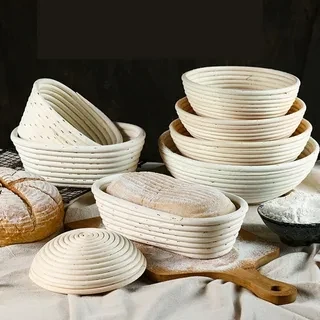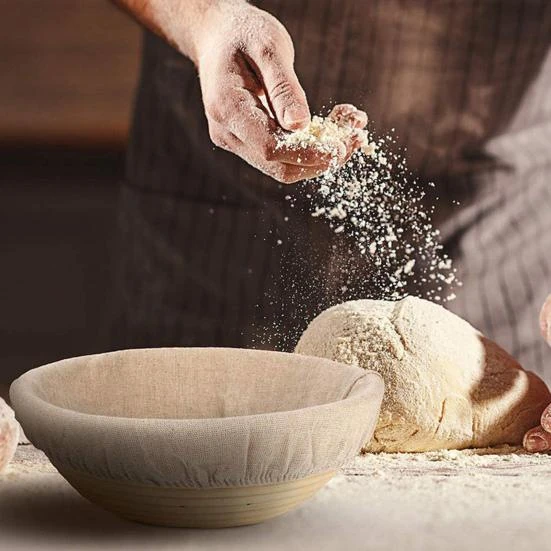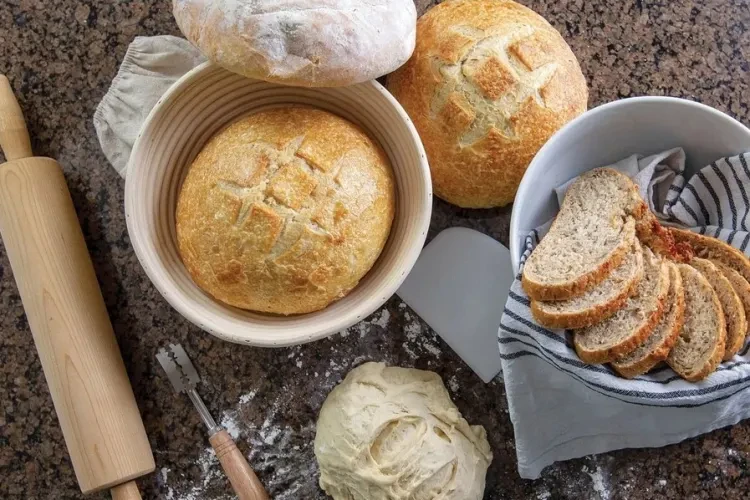How to Use Banneton Baskets

For artisan bread bakers, banneton baskets also known as proofing baskets or protoforms that are essential equipment. They impart a crusty, tight spiral structure and help dough to retain its shape in the final proofing stage. Even the most novice bakes can use banneton properly to significantly improve the shape and appearance of their loaf. This article includes how to use a banneton basket, how to use it with a liner, and how to care for your basket.
What is a Banneton Basket?
A banneton basket is a proofing basket made of cane or natural rattan that is circular or oval. Its purpose is to support sticky, wet dough so that it doesn’t spread too much and to allow air to circulate the dough, resulting in a crisp crust.
Why Use a Banneton Basket?
- Keep the dough’s shape while it’s being proofed.
- Enables improved aeration and fermentation.
- Gives the crust a rustic spiral design.
- It inhibits excessive spreading and aids in even rising.
Use a Banneton Basket
When you use a banneton basket correctly, the dough will take on the ideal shape and not stick. Here is a detailed guide:
Step 1: Getting the Basket Ready
Prior to making your first use of your banneton:
- Sprinkle the basket with a little bit of flour, preferably rice flour, which keeps things from sticking, as well as ordinary flour.
- All excess flour should be shaken off.
- If you want to have a nice texture on your bread, you can optionally use a liner.

Step 2: Forming the Dough
- Form your dough into an oval (batard) or round (boule) shape once it has undergone bulk fermentation.
- Put it in the floured banneton seam-side up. In this manner, the smooth side will be on top when you flip it onto a baking surface.
Step 3: Make the dough proof
- To keep the banneton from drying out, cover it with butter paper or a dish towel.
- Allow it to be proof for the suggested amount of time at room temperature or, if cold-proof, in the refrigerator.
Step 4: Moving the Dough Around
- Gently flip the banneton onto a baking sheet, peel, or Dutch oven lid after it has finished cooking.
- If the basket was floured correctly, the dough should come out with ease.
- Before baking, score the dough using a sharp (lame) blade.
How to Use Banneton with Liner
A cloth insert known as a liner is used inside the banneton to create a smooth surface free of the spiral imprint.
When to Use Liner:
- If you want a smooth crust without the spiral patterns, liners can be useful.
- They can also be helpful for doughs that are extremely sticky.
- When bakers want to create scoring designs on their bread, liners come in rather handy.
This is how you utilize it:
Step 1: Getting the Liner Ready
- The liner should be put into the basket.
- Sprinkle the lining with a little bit of flour.
Step 2: Adding the Dough
- As before, shape the dough and put it seam-side up in the lined banneton.
- Let it be proof by covering it.
Step 3: Moving the Dough Around
- Lift the liner’s borders to remove the dough gently.
- Before baking, turn it onto the baking surface and score it.
How to Keep Your Banneton Basket in Good Condition?
Your banneton will last longer and remain clean with proper care.
After Each Use:
- Excess flour should be shaken out.
- Let the basket air dry entirely.
Thorough Cleaning:
- If necessary, remove any sticky flour with a dry brush.
- For tough stains, rinse with warm water (do not soak) and let dry for ten to fifteen minutes in a heated oven (around 200°F/90°C).
- Stay away from soap since it can seep into the rattan and ruin your dough.
Storage Advice:
- To stop mold from growing, store in a dry location.
- Steer clear of dampness.
- If mold forms, brush off residue and kill bacteria overnight by placing the basket in an overheated oven.

Common Mistakes to Avoid
Even experienced bakers can mess up when using banneton baskets. Here are a few things to know:
- The most common mistake leading to sticky dough that isn’t releasing correctly is if you’re using too little flour.
- Over-proofing: Dough that is allowed to rise in a banneton for an extended period may collapse when placed on the baking surface.
- Frequently washing with water can help prevent the growth of mold since rattan absorbs water.
- Rice flour is a superior dusting flour because it absorbs less moisture than regular wheat flour.
Conclusion
A banneton basket is an excellent tool for baking artisan-quality bread at home. Proper preparation and maintenance are critical to preventing sticking and ensuring well-shaped loaves, whether you use them with or without a liner. With these tips, you can up your bread-baking game and produce bakery-level results every time.
Frequently Asked Questions (FAQs)
1. Do you need to season a new banneton basket?
Yes, dust it lightly with rice flour the first time you use it to keep things from sticking. It will become more non-stick the more you use it.
2. Why does my dough stick to the banneton?
It might not have enough flour. Make sure the basket is thoroughly dry before using it, and use rice flour for improved release.
3. Is it possible to bake straight in a banneton?
No, Bantons are only used for proofreading. Transfer dough to a Dutch oven or baking sheet before baking.
4. Do I need to use a liner?
Yes, but only if that is how you like it. Whereas an unlined banneton leaves a rustic spiral design, a liner produces a smooth surface.
